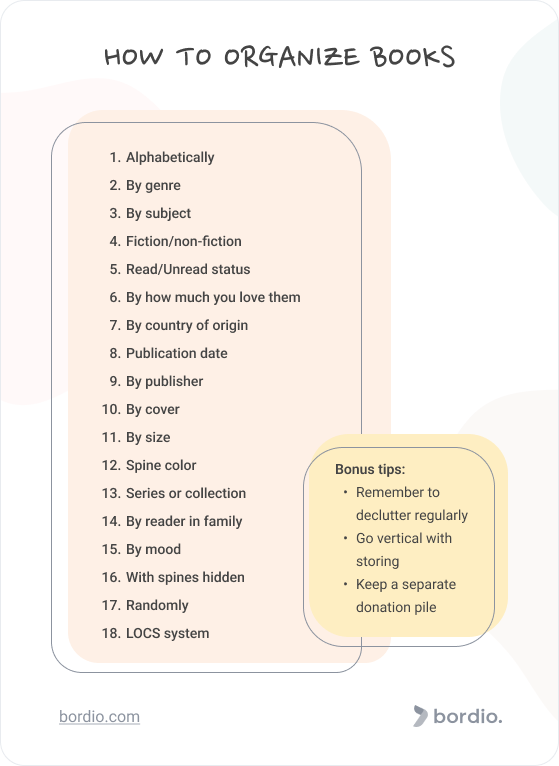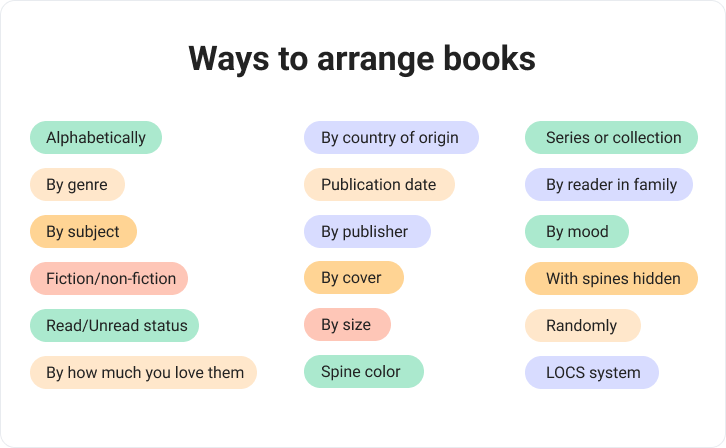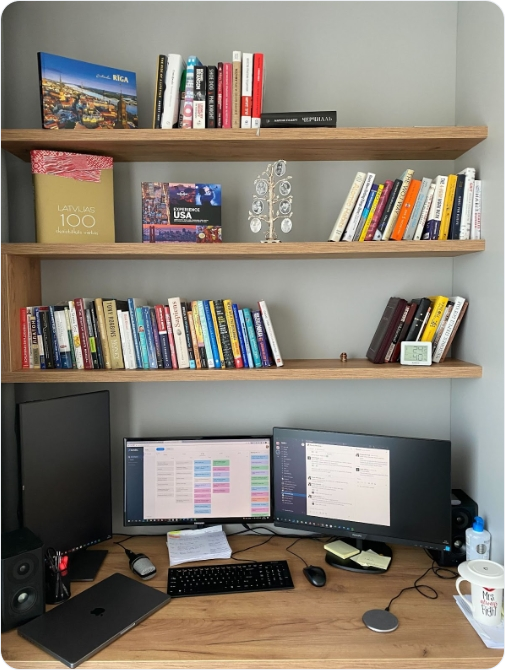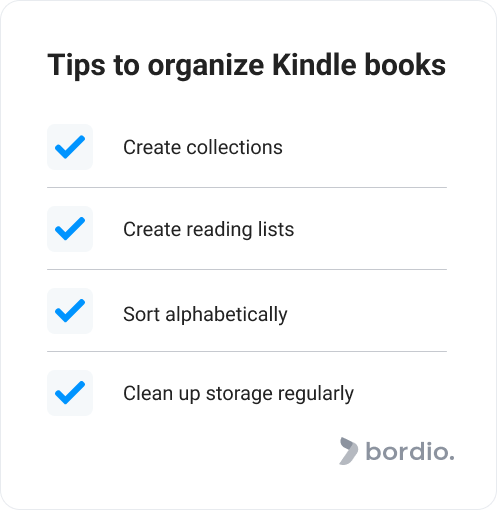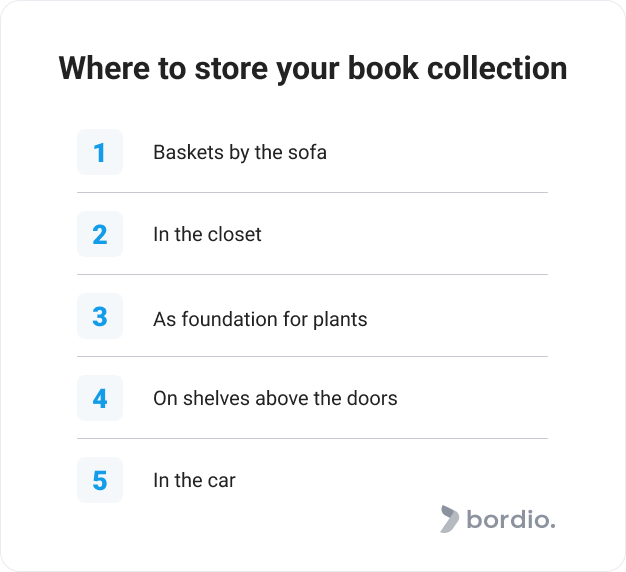If you are an avid book lover like us, you too are familiar with the issue of forever cluttered bookshelves and having all your horizontal spaces occupied with random piles of dusty books.
E-book readers with a Kindle library completely untouched can be fine, but for all physical copy lovers storing and organizing is a real struggle.
But no more! Our guide, with many creative and time-tested ideas, will help you organize your books once and for all.
And if you’re up for more self-improvement content, check out the expert articles about habit forming and good habit examples, building routines for a healthy lifestyle, and how successful people plan their days.
Ways to arrange your books
We’ve prepared a list of methods to organize books so you never have to feel inundated with your collection again.
#1 Alphabetically
This practical classic is a library’s best practice and would work for anyone who’d like to have a simple and proven way to catalog and search their books. We personally would arrange them by authors, but going with book titles is a perfectly fine option too.
Bonus tip: As your book collection expands, you might find yourself in a peculiar position of having to move all your shelves to accommodate new copies. To avoid that, leave each shelf slightly empty, e.g. one-third of it, so when you have new books to add, you’ll have plenty of room for it. Same as you would not plan every minute in your online daily planner because there is always something being added to it, whether a task or a last-minute meeting.
#2 By genre
Arranging books by genre is the second most popular organizational system. It will not only make locating books easier, but will also be super helpful when you are in the mood to read something specific, like a particular novel type, and want to see your options. This organizing method is particularly handy for those who enjoy re-reading their collection or have a bunch of new, unread books.
#3 By Subject
This method is a bit less universal as it will work best for those who read a lot about particular matters. As a compromise, you can organize part of your collection by subject, for example, if you really like time management or non-fiction books and have a whole selection of them.
By the way, we also like time management books and created a best-seller list, so make sure you check it out.
#4 Fiction and non-fiction
It’s easy and it is effective. Keep your fiction books in one place, and all non-fiction in the other. This organizing method takes little time and barely any maintenance moving forward.
#5 By read/unread status
One of the problems that readers face is getting too many new books and never reading them.
While there are many reasons why that happens, some of the blame can be put on the fact that they get lost and spread out, so we never see them really. A solution to this would be to, you guessed it, separate all the unread books and put them in one place. Ideally somewhere you would see them all the time, like eye-level shelves. You can also challenge yourself to not buy new books unless you’ve read at least 5 copies from your shelf.
Tip: You can organize your mental book clutter too! Sign up for Bordio’s free online to-do list and use the Waiting List feature that acts as an additional to-do list for all unscheduled tasks, ideas, and plans. Whenever you think of a book you’d like to read – save it on the Waiting List and avoid stressing your brain with having to remember everything at once. And by the way, you can use this trick for everything, making it a helpful tool tool for your mind sweep sessions.
#6 By how much you loved them
You may not be re-reading your favorite books soon, but wouldn’t it be nice to display them all in one place and have an occasional peek? Plus, next time someone asks you for book recommendations, you will be prepared to give them a full list or send a photo of your shelf.
#7 By country of origin
If you enjoy reading authors from different regions and have a wide variety in your collection, then show it! It’s nice to have all your Russian authors in one place and then Australian ones in another. That way, your home library will not only look well-organized but also professional.
Bordio’s team uses this method all the time. Whenever we travel and work remotely, we bring back books that find a special place on our bookshelves. Mentioning this we also advise you to use software to manage remote employees and collaborative tools for remote working if you travel often and work remotely.
#8 By publication date
Yes, we know. This organization method looks like too much work, especially in modern life where everyone’s weekly planners are stuffed with endless task lists. And it is! But imagine having your books all done, and having a visual representation of literary history. How cool is that! You might use it as a way to learn more about the inter-dependencies and influences of authors on one another, and remember when they all lived. Plus, you get to show off when your friends come to visit and ask you about your organizing system.
We bet they won’t be expecting what you’ll have to say.
#9 By publisher
Have you seen those cozy and inspiring Instagram photos with Penguin books collections?
If you have many books by certain publishers, grouping them together can work as a great organizing system and elevate your room design too.
#10 By cover
Unless you are specifically purchasing only paperbacks or hardcovers, you end up having both. Hardcovers tend to be bulkier, so by separating the two you might have less difficulty finding space for all of your books.
#11 By size
Looking at bookshelves that form a perfect line when all books are the same size is deeply satisfying, so you can try and reach that perfection at your home. Or, by contrast, have them all mixed up and look cute.
#12 By spine color
This way of organizing books will take you a bit more time as you initially work through your book collection, but more importantly, it will require more maintenance as you acquire new books. If you’re up for the challenge and like re-organizing things over and over again, then going with color options is what you need. Plus, it will look hella impressive on social media.
Ps – there are tons of judgy comments about categorizing your books by colors online, but don’t let anyone’s snide attitude ruin your fun.
#13 By series or collection
If you have all “Lord of the rings” books, it only makes sense to put them all together, right? Equally, if you have a collection of books by a certain author from the same publisher, they will look good together. And it will be easy to browse your shelves going from one collection to another.
#14 By reader
If you are blessed to live in a reading household, you can have designated areas for each reader at home. That way, you will know exactly where your books are, and your kids won’t be picking up books that they are too early to read.
#15 By mood
Books can be organized by the mood and the emotions they give you. If you have books that scare you or make you laugh – keep them together. That way, when you’re in the mood to cry or feel adventurous, you’ll know exactly which shelf to check out.
#16 With spines hidden
If you hide all the spines of the books and face them on the opposite side, you will have a minimal, Instagram-worthy look. The downsides here are obvious – if you actually want to find your books and be able to use the shelves, then this is not for you.
Or perhaps, if your bookcase stands in the middle of the room and is see-through, you can pull it off and have a monochromatic look on one side, and a usual one on the other.
#17 Randomly
Remember that you don’t have to organize your books. You should only do it if it makes sense to you and you enjoy the process. After all, life is too short, and you might as well dedicate those few hours to reading your books, and not moving them from one shelf to the other.
#18 By LOCS
The Library of Congress System or LOCS book organizing system is rather popular and inclusive that is used by many academic libraries. It starts with a selection of broad categories that are further divided into smaller sub-categories. You can find a full list of categories on their official website.
By the way, here is what a part of the book’s setup of our CEO, Jacob Udodov looks like
The bottom shelf is reserved for unread books, the middle shelf holds the absolute must-reads according to Jacob, and the top shelf is for autobiographies. The rest is hidden in the closet.
How to organize Kindle books
Your Kindle app will automatically organize books into a separate category, but it can be tricky to manage the kindle content log if you have 100 books or more.
To keep your Kindle books organized, create Kindle collections for books that you’d like to read or books that belong to the same genre, such as mystery stories. You can also create reading lists to make sure you won’t forget about something.
Your Kindle device naturally sorts books alphabetically which can also work if you have no interest in organizing the digital space. But even if you have Kindle unlimited storage, clean it up every once in a while to get rid of books you didn’t like or have already read. That way, random browsing through the Kindle app will be much more fun.
Where to store your books
Books traditionally take up our shelf space but they don’t have to just live there.
With a little bit of creativity, you can arrange books all around the apartment without creating visual clutter:
- Use baskets to store books and put them on the floor by the sofa or bed.
- If you’re a clothes minimalist and your closet sits half empty – it is a good place to store part of your existing collection.
- Bigger, heavier books can work as a great foundation for plant pots.
- Build a shelf above the door (e.g. in the bedroom) and create extra shelf space.
- A few novels can go in your car – perfect for when you’re stuck waiting for your kid’s extra curriculums to end.
More book organizing tips
Here are a few extra organizing tips to help you maintain your library in order:
Have a separate pile or a shelf for the books you are ready to let go
Then, when the opportunity presents itself, you will have a selection of books that you can donate to friends that need a beach read or your community library that is hungry for newer releases.
Declutter regularly
In addition to keeping a pile of books for sharing with others, go through your library every once in a while and see if you can downsize here and there. Unless you are particular about keeping every book you’ve ever read, there is no reason to keep even the copies you didn’t enjoy or the ones that fell in the pool on your vacation and kind of fall apart now. If you feel very attached to your books, help yourself with the Marie Kondo-style questions: Did I love this book when I was reading it? Does it have sentimental value? Is this a kind of book I might re-read in the future?
Go vertical
Your shelves don’t have to be horizontal, you can pile your books vertically which can look very pleasing. In addition to that, you’ll be able to save more space as vertical storage allows you to fully utilize the bookshelf height.
Tip: If you’re looking to organize more than just your books, go ahead and download Bordio’s online calendar planner to structure your tasks and plan your goals. Bordio is a personal and team productivity solution that promotes sustainable efficiency and enables you to reach new heights.
How to take care of your books
We love our books and want to keep them in pristine condition. To achieve that, follow the simple rules we’ve outlined below and enjoy your favorite books for longer.

- Store your books away from direct sunlight to prevent color fading.
- Make sure the rooms where books are stored are dry, so the moisture and mold won’t ruin them.
- Dust your books every once in a while.
- Show your books some love – read and re-read them.
By the way, if you are not sure what to read next, we have a list of best project management and productivity books for you.

